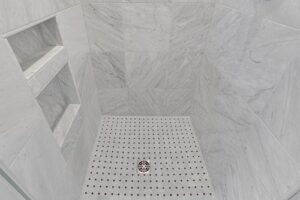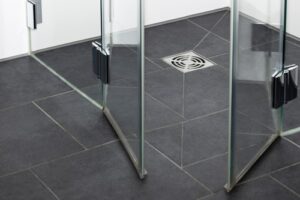Every homeowner knows the joy of a refreshing shower, but few anticipate the inconvenience when their shower decides to start having issues and malfunctioning. Many of the problems that can happen to a shower come from the drain itself. From slow drainage to foul odors wafting up from the depths, the signs of a troubled shower drain are hard to ignore.
While some issues might seem minor and DIY-friendly, others signal a deeper plumbing problem that demands professional attention. In this article, we’ll explore the common headaches homeowners encounter with their shower drains, and when it’s time to call in the experts for a helping hand.
Shower Drain Clogs and Blockage
Clogs in a shower drain are a common and frustrating issue that many homeowners encounter. These clogs typically occur when hair, soap residue, dirt, and other debris accumulate in the drain over time, obstructing the flow of water. Here’s a more detailed look at clogs in shower drains:
Hair Buildup: Hair is a primary culprit for shower drain clogs. As we wash our hair, strands can become tangled and collect near the drain opening. Over time, this hair can accumulate, forming a dense blockage that prevents water from flowing freely.
Soap Scum: Soap residue, along with minerals from hard water, can combine to create a sticky substance known as soap scum. This scum can adhere to the walls of the drain pipes, trapping other debris and contributing to clogs.
Dirt and Grime: Dirt, mud, and other particles washed off the body can also contribute to clogs in the shower drain. These materials can mix with soap scum and hair, creating a stubborn blockage that is difficult to remove.
Inadequate Drain Covers: Many shower drains are equipped with covers or grates designed to catch larger debris and prevent it from entering the drain pipe. However, if these covers are missing or damaged, debris can easily enter the drain and contribute to clogs.
Improper Drain Slope: The slope or angle of the drain pipe plays a crucial role in facilitating proper drainage. If the drain pipe is not sloped correctly, water may pool in certain areas, allowing debris to accumulate and form clogs
Foreign Objects: Occasionally, objects such as jewelry, small toys, or toiletry items may accidentally fall into the shower drain, leading to blockages. These objects can get lodged in the drain pipe, impeding water flow and causing backups.
External Factors: External factors such as tree roots intruding into underground pipes or pipe damage due to shifting soil or ground settling can also contribute to shower drain clogs.
Slow Drainage: Even if there isn’t a complete blockage, homeowners may notice that water is draining more slowly than usual. This could indicate a partial clog or buildup within the pipes, restricting the water flow.
To address shower drain clogs, homeowners can try using a plunger, plumbing snake, or chemical drain cleaner to break up and remove the blockage. However, for stubborn or recurring clogs, it’s best to seek the assistance of a professional plumber who can thoroughly assess the situation and provide effective solutions, such as hydro-jetting or pipe replacement if necessary. Additionally, implementing preventive measures like using drain covers, regularly cleaning the drain, and avoiding the introduction of foreign objects can help minimize the risk of future clogs.
Issues With Foul Odors From a Shower Drain
Foul odors emanating from shower drains can be unpleasant and disruptive to the bathing experience. These odors are often a sign of organic matter decomposition within the pipes or bacterial growth, and they can result from various factors. Here’s a closer look at the causes of foul odors in shower drains:
Accumulated Debris: Over time, hair, soap scum, dead skin cells, and other organic matter can accumulate in the drain pipes. As this debris decomposes, it releases foul-smelling gasses that can permeate through the drain and into the bathroom.
Bacterial Growth: The warm, moist environment of shower drains provides an ideal breeding ground for bacteria and other microorganisms. Bacteria can thrive on organic matter trapped in the pipes, producing unpleasant odors as they metabolize and break down waste materials.
Mold and Mildew: Mold and mildew are types of fungi that thrive in damp, dark environments. If moisture is allowed to accumulate in the drain pipes or surrounding areas, mold and mildew can develop, emitting musty or earthy odors that can be noticeable in the bathroom.
Biofilm Formation: Biofilm is a slimy layer that can form on the surfaces of drain pipes, consisting of bacteria, fungi, and other microorganisms. As biofilm accumulates, it can trap debris and organic matter, contributing to foul odors and potentially causing blockages in the drain.
Sewer Gas Intrusion: In some cases, foul odors in shower drains may be due to sewer gas intrusion. Sewer gasses, such as hydrogen sulfide and methane, can enter the home through drains if there are problems with the plumbing system, such as damaged or improperly sealed pipes, or if there is inadequate venting.
Dry P-Traps: The P-trap is a curved section of pipe beneath the drain that is designed to hold water and create a seal, preventing sewer gasses from entering the home. If a shower is not used frequently, the water in the P-trap can evaporate, breaking the seal and allowing odors to escape from the drain.
Chemical Reactions: Chemical reactions between different substances, such as hair products, soaps, and cleaning agents, can occur in the drain pipes, leading to the formation of odorous compounds.
When dealing with foul odors emanating from shower drains, homeowners can try several methods, including flushing the drain with hot water, using baking soda and vinegar to clean the pipes, or utilizing commercial drain cleaners. However, if the odors persist or are accompanied by other plumbing issues, such as slow drainage or gurgling noises, it’s advisable to consult a professional plumber to identify and address the underlying cause effectively. Additionally, implementing regular cleaning and maintenance practices can help prevent foul odors from recurring in the future.
In conclusion, the humble shower drain, often taken for granted, can become a source of frustration and inconvenience for homeowners when issues arise. From stubborn clogs to foul odors and everything in between, the problems that can plague shower drains are varied and sometimes complex. However, by understanding the common causes of these issues and taking proactive measures to address them, homeowners can restore the functionality and tranquility of their shower experience.
Whether it’s implementing regular cleaning routines, using drain covers to prevent debris buildup, or seeking professional assistance for more significant plumbing concerns, there are solutions available to tackle shower drain problems head-on. By staying vigilant and addressing issues promptly, homeowners can avoid the headache of costly repairs and maintain a smoothly functioning plumbing system for years to come.
Ultimately, a well-maintained shower drain not only ensures efficient water drainage but also contributes to the overall comfort and cleanliness of the home. So, the next time you find yourself facing a troublesome shower drain, remember that with a little knowledge and effort, you can keep this essential component of your bathroom in tip-top shape.
